113 Painting Rack 9
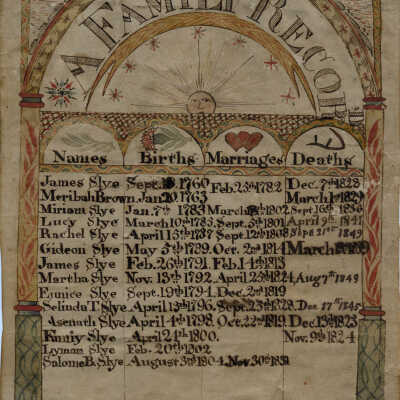

A Family Record
Name/Title
A Family Record
Description
A calligraphy record of names, births, marriages, and deaths of the Slye family of Bennington County. The record begins with James Slye, born Sept. 1760, and ends with Salome B. Slye, born August 3, 1804. The paper is decorated with pen and ink and watercolors, featuring decorative columns supporting an arch that encloses the words "A Family Record" along with a rising sun. The art work has been affixed to a paper backing. The family record is set in a wooden frame with glass; the guilded frame is of molded wood with mitered corners.
Acquisition
Accession
2010.31
Relationships
Related Person or Organization
Slye, James Bumpus (1760-1828), Brown, Meribah (1763-1829), Slye, Miriam (1783-1836), Slye, Lucy (1785-1841), Slye, Rachel (1787-1849), Slye, Gideon (1789-1839), Slye, James (1791-1862), Slye, Martha (1792-1849), Slye, Eunice (1794-1866), Slye, Selinda T. (1796-1845), Slye, Asenath (1798-1823), Slye, Fanny (1800-1824), Slye, Lyman (1802-1862), Slye, Salome (1804-1866)
Related Places
Place
Shaftsbury
Town
Bennington County
County
Vermont
State/Province
United States of America
Country
North America
Artwork Details
Medium
Watercolor, Ink
Subject
Slye family of Shaftsbury, Vermont
Dimensions
Width
9 in
Height
11-3/8 in
Entry/Object ID
2010.31.18
Context
This intricate family record was created for the Slye family of Bennington County, Vermont. Based on the handwriting and history of ownership, it was probably created for daughter Martha Slye on the occassion of her marriage in 1824 or perhaps the birth of a child a few years later. Death and marriage entries after the 1820s are executed in a different hand and the record ceases to record information at Martha's death in 1849. The wooden backing of the frame has further marriage information documenting the descent of the record through mostly a female line to the donor.
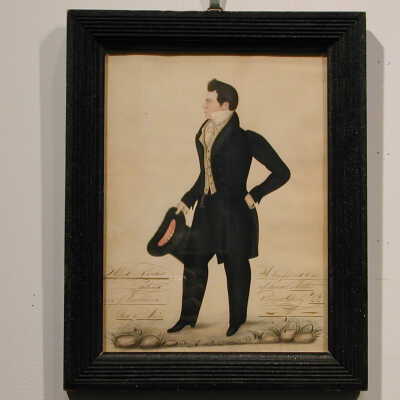

Alfred Randall
Name/Title
Alfred Randall
Description
Full length profile portrait of a young man in pen and ink with watercolor highlights. The man faces left and has his left hand on his hip. He holds a tall beaver hat in his right hand. He is dressed in black pants, a black cutaway jacket, a cream colored vest, a white shirt with stand-up collar, and and a white cravat. Pinned to the cravat is a gold chain with a brooch. A blue and red watch fob with metal ornament drapes from his right front hip area. The man's hair is cut short, swept forward in front of the ears and forward, and into a wave at the forehead. There is stylized grass and rocks in foreground, and written in ink on left side of portrait is the inscription, "Alfred Randall/ Portland/ County of Cumberland/ State of Maine" Written in ink on right side of portrait is, "A Compliment to his/ affectionate Mother/ Resident Derby V.T."
Acquisition
Accession
1985.7
Artwork Details
Medium
Watercolor, Ink
Subject Person
Randall, Alfred (1803-1879)
Made/Created
Date made
circa 1830
Dimensions
N/A
Entry/Object ID
1985.7.4
Context
Alfred Randall, a native of Greensboro, Vermont, had this portrait produced for his mother while he resided in Portland, Maine. Portraits such as this were created by first tracing a silhouette of the sitter and then filling in facial features. The body was usually a generic form the sitter could choose to finish out the artwork.


Champlain
Name/Title
Champlain
Description
"Samuel de Champlain explores the southern reaches of the Lake with his Algonquin and Huron allies 1609"
Black ink on off-white paper. Middle foreground is a canoe with three men, the one in fron represents Champlain with two men rowing behind him. Two additional canoes in image, one to seft with two Huron's in it and one in back with two Huron's in it. Rolling hills/mountains in background. Flock of birds in left sky area. Compass points in right sky area. Superimposed at the far right over scene is a cartargaphers view of "Lac Champlain" At the lower right is a small (1.63" dia) bust of Champlain. Text as written above is below the artwork. In pencil between art and text is "Champlain 6/40 M. Simpson"
Black ink on off-white paper. Middle foreground is a canoe with three men, the one in fron represents Champlain with two men rowing behind him. Two additional canoes in image, one to seft with two Huron's in it and one in back with two Huron's in it. Rolling hills/mountains in background. Flock of birds in left sky area. Compass points in right sky area. Superimposed at the far right over scene is a cartargaphers view of "Lac Champlain" At the lower right is a small (1.63" dia) bust of Champlain. Text as written above is below the artwork. In pencil between art and text is "Champlain 6/40 M. Simpson"
Acquisition
Accession
2009.2
Artwork Details
Subject Person
Champlain, Samuel de (1580-1635)
Subject
Champlain's exploration of Vermont
Made/Created
Artist Information
Simpson, Mary Gorham (b.1945)
Artist
Date made
2009
Dimensions
Width
12-7/8 in
Height
16 in
Entry/Object ID
2009.2.6
Context
Currently residing in Lyndonville, Mary Gorham Simpson was born in northern Vermont and raised on a working dairy farm in Burke. After graduating from Lyndon State College, she and her husband, Wilder Simpson, taught school in the area for several years, then moved west. They lived for seven years in Wyoming and 14 years in Alaska, returning to Vermont in 1992.
While raising her three children, Simpson took art classes and worked on her own in various media - drawing, calligraphy, and painting. In Alaska, she worked as a graphic artist for the Imaginarium Science Center in Anchorage and as a scenic artist for the Alaska Festival Theater and Anchorage Civic Opera. She did scrimshaw for two shops and exhibit calligraphy for three years for the Anchorage Museum of History and Art.
Now back in Vermont, she mostly works as a printmaker with subjects reflecting memories of Vermont agriculture.
While raising her three children, Simpson took art classes and worked on her own in various media - drawing, calligraphy, and painting. In Alaska, she worked as a graphic artist for the Imaginarium Science Center in Anchorage and as a scenic artist for the Alaska Festival Theater and Anchorage Civic Opera. She did scrimshaw for two shops and exhibit calligraphy for three years for the Anchorage Museum of History and Art.
Now back in Vermont, she mostly works as a printmaker with subjects reflecting memories of Vermont agriculture.
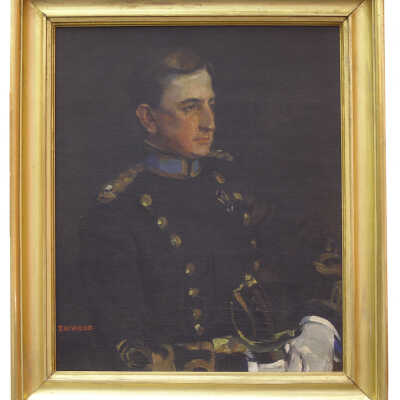

Civil War Officer
Name/Title
Civil War Officer
Type of Painting
Description
Portrait showing a naval officer wearing a double-breasted uniform coat. The coat has a standing collar decorated in light blue edged with gold. He is wearing gold, braided epaulets. Addition gold braid decorates his sleeves. He is wearing white gloves and holding a sword in both of his hands. The piece is prominently signed in lower left in red: "T. W. Wood."
Acquisition
Accession
2011.13
Catalog Information
Relationships
Related Events
Civil War
Event
Artwork Details
Medium
Oil
Subject
Military officer
Made/Created
Artist Information
Wood, Thomas Waterman (1823-1903)
Artist
Date made
1902
Dimensions
Width
30-7/8 in
Height
35-3/4 in
Depth
3 in
Entry/Object ID
2011.13.1
Context
The name of this naval officer has been lost to time, but the portrait is a fine example of Thomas Waterman Wood's artwork.
The son of a cabinetmaker, Thomas Waterman Wood was born in Montpelier, Vermont in 1823. He showed an early aptitude for painting and was apprenticed to Boston portrait artist Chester Harding.
In 1850 he married and built a carpenter gothic summer home in Montpelier. For much of the ensuing decade he traveled throughout the U.S., Canada, and Europe while supporting himself through portrait painting.
Wood set up a permanent studio in New York City with a specialty on figure drawing. During and after the Civil War he started creating genre paintings which brought him national recognition. He was ultimately accepted in the National Academy of Design and served as its vice-president and president.
He continued to spend summers in Montpelier and considered Vermont his home. His portraits are very common throughout central Vermont with many held by the Vermont Historical Society. Upon his death he left funds to create the T.W. Wood Gallery in Montpelier. He chose to be buried in Montpelier's Green Mount Cemetery.
The son of a cabinetmaker, Thomas Waterman Wood was born in Montpelier, Vermont in 1823. He showed an early aptitude for painting and was apprenticed to Boston portrait artist Chester Harding.
In 1850 he married and built a carpenter gothic summer home in Montpelier. For much of the ensuing decade he traveled throughout the U.S., Canada, and Europe while supporting himself through portrait painting.
Wood set up a permanent studio in New York City with a specialty on figure drawing. During and after the Civil War he started creating genre paintings which brought him national recognition. He was ultimately accepted in the National Academy of Design and served as its vice-president and president.
He continued to spend summers in Montpelier and considered Vermont his home. His portraits are very common throughout central Vermont with many held by the Vermont Historical Society. Upon his death he left funds to create the T.W. Wood Gallery in Montpelier. He chose to be buried in Montpelier's Green Mount Cemetery.
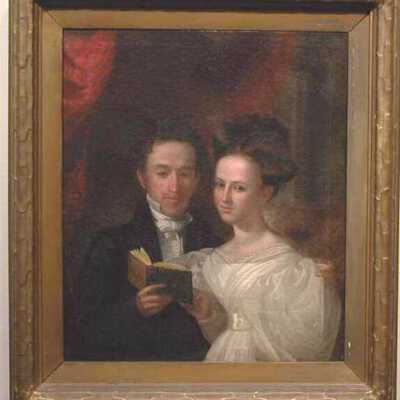

Daniel Pierce Thompson and Eunice Wright Robinson Thompson
Name/Title
Daniel Pierce Thompson and Eunice Wright Robinson Thompson
Type of Painting
Description
Portrait showing a man and woman. The man is wearing a black suit jacket and a white shirt with a pleated cravat. He is holding up a small open book. The woman is wearing a white dress with large, transparent sleeves. Her hair is parted down the center and held in two bow shapes on either side of the part. She is looking at the viewer, and her hand is indicating a passage from the book. The pair is seated in an interior with red drapery behind. The man's arm is around the woman at her shoulder.
Acquisition
Accession
1957.40
Artwork Details
Medium
Oil
Subject Person
Thompson, Daniel Pierce (1795–1868), Thompson, Eunice Wright Robinson (1814-1894)
Made/Created
Artist Information
Mason, Benjamin Franklin (1804-1871)
Artist
Date made
circa 1831
Dimensions
N/A
Entry/Object ID
1957.40.1
Context
The portrait shows Daniel Pierce Thompson, the famous Vermont author and one of the founders of the Vermont Historical Society, and Eunice Wright Robinson Thompson. It was painted shortly after their marriage in Montpelier by the itinerant portrait painter, Benjamin Franklin Mason.
Benjamin Franklin Mason was born in Pomfret, Vermont into a large farming family. At the age of nine he suffered paralysis of the lower portion of one of his legs from which he never recovered. The disability prevented him from pursuing farming or other physical professions. Instead he discovered and aptitude for art and became an itinerant portrait painter.
It's probable that he studied with Abraham Tuthill, an urban-trained painter who regularly visited family in Pomfret. He later spent time in Boston where he likely studied with other portrait painters of the day.
Mason spent significant time in Middlebury, Vergennes, Montpelier, and, at the end of his life, Woodstock, Vermont. He travelled widely at the invitation of clients with roots in Vermont. He is known to have painted in Wisconsin, Michigan, and Buffalo, New York.
Hi painted portraits of Vermonters are quite numerous with many in public and private collections throughout the state.
Benjamin Franklin Mason was born in Pomfret, Vermont into a large farming family. At the age of nine he suffered paralysis of the lower portion of one of his legs from which he never recovered. The disability prevented him from pursuing farming or other physical professions. Instead he discovered and aptitude for art and became an itinerant portrait painter.
It's probable that he studied with Abraham Tuthill, an urban-trained painter who regularly visited family in Pomfret. He later spent time in Boston where he likely studied with other portrait painters of the day.
Mason spent significant time in Middlebury, Vergennes, Montpelier, and, at the end of his life, Woodstock, Vermont. He travelled widely at the invitation of clients with roots in Vermont. He is known to have painted in Wisconsin, Michigan, and Buffalo, New York.
Hi painted portraits of Vermonters are quite numerous with many in public and private collections throughout the state.
Web Links and URLs
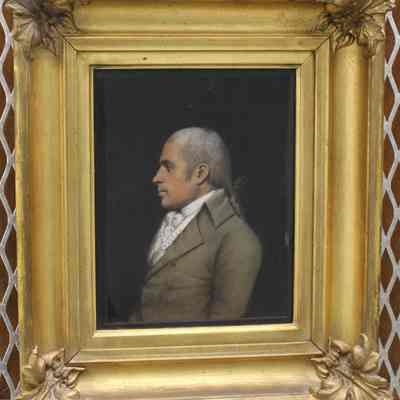

Elijah Paine (1757-1842)
Name/Title
Elijah Paine (1757-1842)
Type of Painting
Description
Pastel of Elijah Paine (1757-1842) behind beveled glass [with black spacer]. Profile of man facing left, short gray hair with back braid. Clean shaven wearing a taupe coat and white cravat. His vest has a dark line running through the fabric.
Acquisition
Accession
2013.50
Relationships
Related Person or Organization
Paine, Elijah (1757-1842)
Person or Organization
Artwork Details
Medium
Pastel
Subject Person
Paine, Elijah (1757-1842)
Made/Created
Artist Information
Sharples, James, Sr. (1751-1811)
Artist
Date made
circa 1796
Dimensions
Width
13-1/4 in
Height
15 in
Depth
3 in
Entry/Object ID
2013.50.3
Context
A Revolutionary War veteran and Harvard graduate, Elijah Paine first settled in Windsor, Vermont and then later in Williamstown.
In addition to farming and owning a series of businesses, he also maintained a law practice. He served a number of state elected positions, including representative from Williamstown. He was the secretary to the 1777 Vermont Constitutional Convention and served in Vermont's judiciary as both probate judge and supreme court justice. We was a Federalist United States Senator from 1795 to 1801 when he was appointed and resigned to become the United States District judge for the district of Vermont by President John Adams.
James Sharples, the artist who created this work, was an English immigrant to the new United States and made much of his career in painting profile portraits of prominent U.S. politicians. He used a device called the physiognotrace to produce an accurate silhouette of the sitter and then filled out the remainder of the portrait. He retained the original tracing so that he could produce and sell copies of popular likenesses.
In addition to farming and owning a series of businesses, he also maintained a law practice. He served a number of state elected positions, including representative from Williamstown. He was the secretary to the 1777 Vermont Constitutional Convention and served in Vermont's judiciary as both probate judge and supreme court justice. We was a Federalist United States Senator from 1795 to 1801 when he was appointed and resigned to become the United States District judge for the district of Vermont by President John Adams.
James Sharples, the artist who created this work, was an English immigrant to the new United States and made much of his career in painting profile portraits of prominent U.S. politicians. He used a device called the physiognotrace to produce an accurate silhouette of the sitter and then filled out the remainder of the portrait. He retained the original tracing so that he could produce and sell copies of popular likenesses.
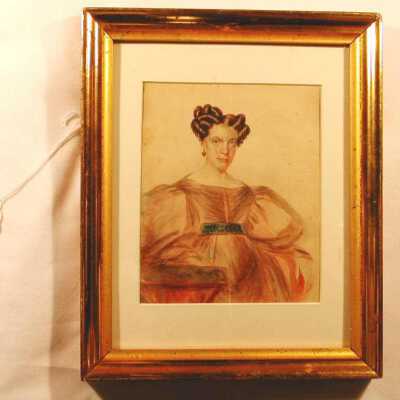

Elvira L. Smith
Name/Title
Elvira L. Smith
Type of Painting
Description
Portrait of a seated woman shown from the waist up. Her body is turned slightly to the right. The woman wears a pink dress with a fitted bodice, flared skirt, and large, puffed sleeves. A green sash or belt circles her waist. Her brown hair is gathered in two large groups of curls on either side of her head.
Acquisition
Accession
1946.47
Artwork Details
Medium
Watercolor
Subject Person
Hendee, Elvira Lois (1811-1900)
Made/Created
Date made
1831-1847
Dimensions
N/A
Entry/Object ID
1946.47.1
Context
Elivra L. Hendee (1811-1900) was born in Pittsford, Vermont in 1811. She married John W. Smith (1804-1847) in 1831 and remarried in 1849 to Sidney Griswold (1809-1862). Since the inscription on the reverse of this drawing indicates her name as Elvira Smith, we can assume it was executed during her marriage to John Smith.
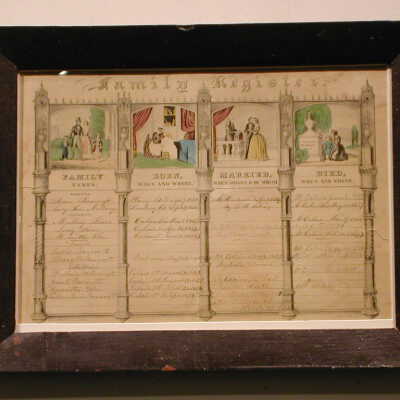

Family Register
Name/Title
Family Register
Description
Lithographic family register of four columns with room for family information. Executed in the gothic revival style, the work has the words "Family Register" at the top and four panels separated by gothic columns. Each panel has an illustration depicting a Victorian scene reflecting the following titles: Family, Born, Married, and Died.
Hand-written entries document the Bancroft family of Calais, Vermont from 1847 to 1888.
Hand-written entries document the Bancroft family of Calais, Vermont from 1847 to 1888.
Acquisition
Accession
1976.43
Relationships
Related Person or Organization
Bancroft, Lewis (1812-1882), Mallary, Lucy Jane (1820-1847), Bancroft, Mallary Lewis (1840-1840), Bancroft, Lucy Jane (1841-1870), Bancroft, Henrietta Glee (1845-1847), Bancroft, Mary H. (1821-1886), Bancroft, Mallary H. (1849-1888), Bancroft, Fran C. (b. 1851), Bancroft, Henrietta Glee (1852-1888), Bancroft, Nathan Lewis (b. 1854)
Artwork Details
Subject
Family Register
Made/Created
Date made
circa 1845
Manufacturer
Currier, Nathaniel (1813-1888)
Dimensions
Width
13-1/2 in
Height
9-1/2 in
Entry/Object ID
1976.43.314
Context
Printed registers such as this have been very popular for over two centuries. Similar posters can be purchased today for documenting family genealogy.
This particular example documents Lewis Bancroft, his two wives, Lucy Jane Mallary and Mary H. Bancroft and their families. It was begun about 1847 and the last entry is in 1888. Based on handwriting, it appears that this register was started at the time of Lucy Jane Mallary's death.
This particular example documents Lewis Bancroft, his two wives, Lucy Jane Mallary and Mary H. Bancroft and their families. It was begun about 1847 and the last entry is in 1888. Based on handwriting, it appears that this register was started at the time of Lucy Jane Mallary's death.
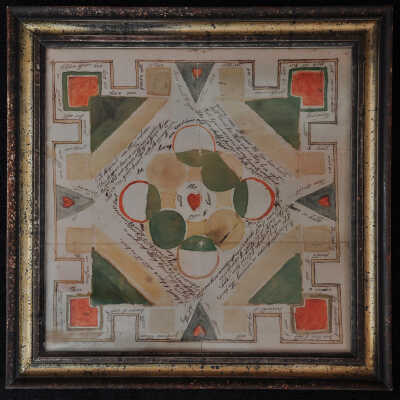

Knot of Love
Name/Title
Knot of Love
Type of Painting
Description
Geometric patterned watercolor and love poem, 1816, Guilford, VT. Called a "knot of love"
In the center of the piece is a red heart surrounded with green and beige circles that stylistically forms a diamond [a square on end]. There are four triangles about 1.13" from each side of the diamond. Those triangles are beige and green. The border around the design consists of uniform straight lines with short inward juts (about 1" x 1"); two per side. Color highlights the borders too. Red/orange, blue, green and beige. Writing that is difficult to read weaves its way through the piece. I'm not sure if it begins in the center with "I send..." or ends there and begins along the outside edge with "A true loves knot..."
In the center of the piece is a red heart surrounded with green and beige circles that stylistically forms a diamond [a square on end]. There are four triangles about 1.13" from each side of the diamond. Those triangles are beige and green. The border around the design consists of uniform straight lines with short inward juts (about 1" x 1"); two per side. Color highlights the borders too. Red/orange, blue, green and beige. Writing that is difficult to read weaves its way through the piece. I'm not sure if it begins in the center with "I send..." or ends there and begins along the outside edge with "A true loves knot..."
Acquisition
Accession
2009.20
Artwork Details
Medium
Watercolor
Made/Created
Date made
1816
Dimensions
Width
15 in
Height
15 in
Depth
1-1/16 in
Entry/Object ID
2009.20.2
Context
A lover's knot or "True Lover's Knot" became a popular form of courting in the late 18th and early 19th century. Based on illuminated letters and designs from the area that is now Germany, the practice seemed to take hold first in southeast Pennsylvania. The practice was adopted from people of German descent by the English Quaker population and from there to other parts of the United States, though they are more rare outside of the mid-Atlantic. Usually written and designed by a young man, the complex romantic poem can be read in a number of ways depending on where you start reading within the work. Geometric designs, hearts, and color forms fill out these enchanting works.
Though often associated with Valentine's Day, these notes were sent throughout the year. This particular lover's knot was sent in November of 1816 within the town of Guilford.
Though often associated with Valentine's Day, these notes were sent throughout the year. This particular lover's knot was sent in November of 1816 within the town of Guilford.
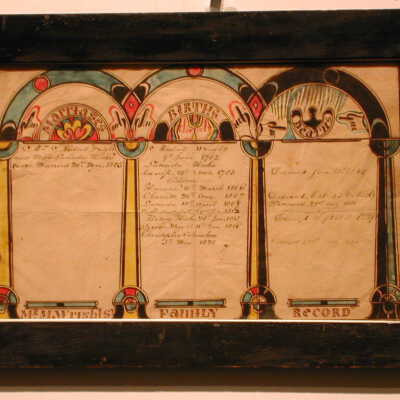

Mr. M. Wright's Family Record
Name/Title
Mr. M. Wright's Family Record
Description
Wright family record. Pen, ink and watercolor. Marriage, birth, and death records of the Medad Wright family are written in the space between highly stylized columns. Above columns are three arches, within which are the words marriages, births, and deaths in semicircular form. Around these words are stylized hearts, hands, and a willow tree. Bases of columns have flared bottoms and semicircular tops.
Relationships
Related Person or Organization
Wright, Medad (b. 1782), Hicks, Lucinda (1783-1849), Wright, Hannah (b. 1806), Wright, Charlotte (1807-1836), Wright, Lucinda (1809-1810), Wright, Medad, Jr. (1812-1892), Wright, Betsey Hicks (1815-1839), Wright, Serena (b. 1816), Wright, Christopher Columbus (1820-1826)
Related Publications
Always in Season: Folk Art and Traditional Culture in Vermont
Publication
Artwork Details
Medium
Ink, Watercolor
Subject
Wright family of Calais, Vermont
Made/Created
Date made
1820-1850
Dimensions
Width
13-1/2 in
Height
8-1/2 in
Entry/Object ID
VHS-A-500
Context
This hand-drawn family register with vibrant colors and unique pointing-hand designs is the work of an unidentified artist working in central Vermont from about 1820 to 1850. Other family registers with similar coloration and design can be found museums around the region. The Atwell family register (A-558) is by the same hand and can be found in this gallery.
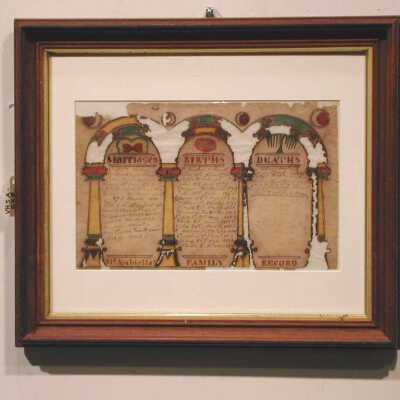

Mr. N. Atwell's Family Record
Name/Title
Mr. N. Atwell's Family Record
Description
Mr. Nathan Atwell's family record. Marriages, births, and deaths--L to R. The sections are separated with columns and archways. they are all in black with color highlights. The colors used are yellow, red and green. There are many entries in the birth column with a few in marriages and deaths. Symbolic drawings under the archways, hearts, and a weeping willow.
Acquisition
Source (if not Accessioned)
Unknown
Relationships
Related Person or Organization
Atwell, Nathan (1766-1844), Hunkins, Lydia (1772-1846), Atwell, Bridgett (b. 1795), Atwell, John (1796-1880), Atwell, Susan (b. 1797), Atwell, William Cummings (b. 1799), Atwell, Hiram (1801-1849), Atwell, Benjamin Hunkins (1802-1883), Atwell, Lydia (b. 1804), Atwell, Phoebe (1806-1889), Atwell, Olive (1808-1884), Atwell, Nathan (b. 1810), Atwell, Caroline (1812-1878), Atwell, James (1814-1895), Atwell, Asher (1816-1900)
Related Publications
A Partial Historie of ye Atwell Race
Publication
Artwork Details
Medium
Watercolor, Ink
Subject
Atwell Family
Made/Created
Date made
1820-1850
Dimensions
Width
20-1/4 in
Height
17 in
Entry/Object ID
VHS-A-558
Context
This hand-drawn family register with vibrant colors and unique designs is the work of an unidentified artist working in central Vermont from about 1820 to 1850. Other family registers with similar coloration and design can be found museums around the region. The Wright family register (A-500) is by the same hand and can be found in this gallery.
The Atwells were early settlers in Johnson, Vermont.
The Atwells were early settlers in Johnson, Vermont.
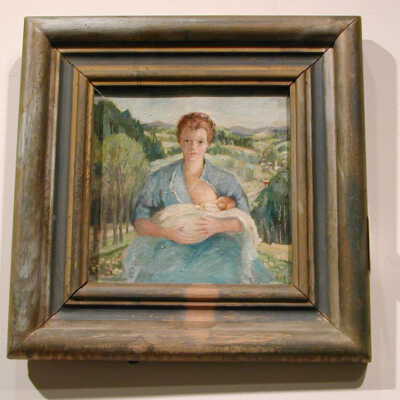

Mrs. Clara Hopkins/ Mother Nursing a Baby
Label
Ruth Greene Mould was born in Morrisville, Vt. She studied art at the Minneapolis Art Institute then returned to VT and taught school. She was well known in the state for her portraits, landscapes, and still-lifes. She did this painting when she lived in Johnson, VT.
Catalog Information
Name/Title
Mrs. Clara Hopkins/ Mother Nursing a Baby
Type of Painting
Description
Small oil painting of young woman with blue dress nursing a baby. Woman is seated in garden with trees to her left and right and a rural scene in the background
Acquisition
Accession
1998.22
Artwork Details
Medium
Oil
Subject Person
Hopkins, Clara Mabel Stiles (1908-2001), Hopkins, Marian Gail (b. 1938)
Made/Created
Artist Information
Mould, Ruth Greene (1894-1979)
Artist
Date made
1938-1939
Dimensions
Width
8 in
Height
8 in
Entry/Object ID
1998.22.25
Context
This portrait depicts Mrs. Clara Hopkins and her daughter Marian of Johnson, Vermont. The Hopkins were dairy farmers and worked the Stiles farm which was originally owned by Clara's parents.
Vermont portrait artist Ruth G. Mould was born in Morrisville, Vermont on May 22, 1894. She was a graduate of local schools, Peoples Academy and Johnson Normal School, which prepared her for an early career as a teacher in the Cadys Falls district school house, teaching Grades 1 - 8. The visual arts, however, commanded her interest as a young woman, and an uncle sponsored her further studies at the Institute of Art in St. Paul, Minnesota, from which she graduated with honors. From there, she went on to study at the Art Students League in New York City, before she married Willis Mould in 1919, and returned to Vermont.
Throughout her married life and beyond, whether she was teaching art students at Johnson Normal School, tutoring private art students, and while she was raising her son, Channing, Ruth Mould's husband made sure she had her own private art studio wherever his work as a mining engineer took his family. They lived in Vermont in Morristown, Monkton, Johnson, Williamstown and Barre, and in New York State in Keysville.
Mould was one of two artists whose work represented the State of Vermont at the 1939 World's Fair in New York. However, she was best known for her portraits, including a posthumous portrait of Edna Beard, first female member of both the Vermont House and Senate, which hangs in the State House, and portraits of three Vermont Chief Justices in the Vermont Supreme Court Building.
In addition to some book illustration, Mould also wrote a book on Refinishing and Decorating Furniture (1953.) She was a member of the Northern Vermont Artist Association and an honorary lifetime member of the Art Students League in New York.
Ruth Mould died on February 13, 1979.
Vermont portrait artist Ruth G. Mould was born in Morrisville, Vermont on May 22, 1894. She was a graduate of local schools, Peoples Academy and Johnson Normal School, which prepared her for an early career as a teacher in the Cadys Falls district school house, teaching Grades 1 - 8. The visual arts, however, commanded her interest as a young woman, and an uncle sponsored her further studies at the Institute of Art in St. Paul, Minnesota, from which she graduated with honors. From there, she went on to study at the Art Students League in New York City, before she married Willis Mould in 1919, and returned to Vermont.
Throughout her married life and beyond, whether she was teaching art students at Johnson Normal School, tutoring private art students, and while she was raising her son, Channing, Ruth Mould's husband made sure she had her own private art studio wherever his work as a mining engineer took his family. They lived in Vermont in Morristown, Monkton, Johnson, Williamstown and Barre, and in New York State in Keysville.
Mould was one of two artists whose work represented the State of Vermont at the 1939 World's Fair in New York. However, she was best known for her portraits, including a posthumous portrait of Edna Beard, first female member of both the Vermont House and Senate, which hangs in the State House, and portraits of three Vermont Chief Justices in the Vermont Supreme Court Building.
In addition to some book illustration, Mould also wrote a book on Refinishing and Decorating Furniture (1953.) She was a member of the Northern Vermont Artist Association and an honorary lifetime member of the Art Students League in New York.
Ruth Mould died on February 13, 1979.
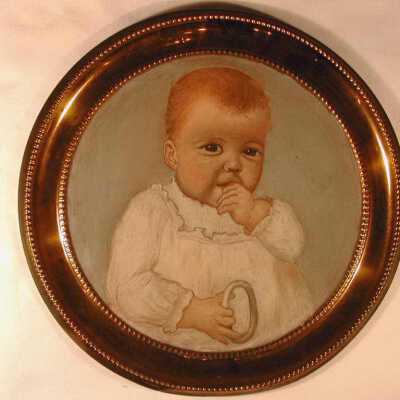

Painting
Name/Title
Painting
Type of Painting
Description
Punched metal tray with a painting of a baby on the center surface. The baby has light pink skin and brown or red hair. It is wearing a white dress. The left hand is at the baby's mouth, and the right hand is holding a white ring toy. The background is painted light blue. The back of the tray is scratched with the label, "S.E. Goddard".
Acquisition
Accession
1958.1
Artwork Details
Medium
Oil, Metal
Made/Created
Artist Information
Hager, Sarah Elizabeth
Artist
Dimensions
Depth
1/4 in
Diameter
12 in
Entry/Object ID
1958.1.1620
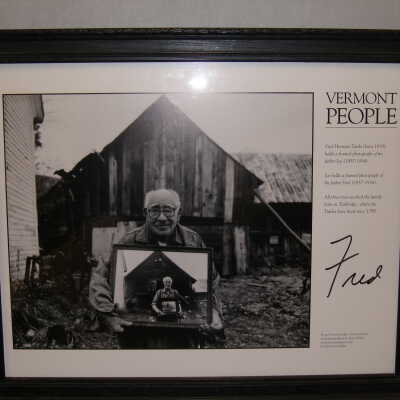

Print, Photographic
Name/Title
Print, Photographic
Description
Framed and autographed print of Fred Tuttle by Peter Miller. Photograph of Fred Herman Tuttle (1919-2003) holding a framed photo of his father Joe Tuttle (1897-1994) holding a framed photograph of his father Fred Tuttle (1857-1916). Signed "Fred"
Acquisition
Accession
2005.54
Relationships
Related Person or Organization
Tuttle, Frederick Herman (1919-2003)
Person or Organization
Artwork Details
Medium
Photographic Paper
Subject Person
Tuttle, Frederick Herman (1919-2003)
Made/Created
Artist Information
Miller, Peter (1934-2023)
Artist
Date made
1998
Dimensions
Width
21-3/4 in
Height
17-3/4 in
Entry/Object ID
2005.54.1
Context
Fred Tuttle became famous through his appearance in the film, "Man With a Plan." In 1998, in what started as a marketing stunt, Fred ran against a political "import" in the Republican senatorial primary. He ended up winning the primary and appeared on the ballot against Democrat Patrick Leahy. This portrait of Fred with his father and grandfather appeared in Peter Miller's first book of photography, "Vermont People." This signed print was issued in 1998 during the senate primary campaign.
Peter Miller was born in New York in 1934 and moved to Vermont at age 13. He bought his first camera at 16 and started photographing his neighbors. He attended the University of Toronto and met photographer Yousuf Karsh. He ended up apprenticing to Karsh and traveling throughout Europe, taking photos of such luminaries as Albert Camus and Pablo Picasso.
He served as a signal corps photographer in the U.S. Army and when his enlistment was up, returned to Vermont as a freelance photographer for national publications. Though he made his living as a commercial photographer, he continued to document the people of his adopted home state.
In the 1980s he shopped the idea for a book of black and white photographs of Vermonters. All the publishing houses rejected the project as old-fashioned. He ended up self-publishing the book, "Vermont People," and sold over 15,000 copies. He followed it up with titles such as "Vermont Farm Women" and "A Lifetime of Vermont People." His last book, "Vanishing Vermonters: Loss of a Rural Culture" was published in 2017.
Miller's work, especially portraits of rural Vermonters, helped define an enduring image of Vermont people.
Peter Miller was born in New York in 1934 and moved to Vermont at age 13. He bought his first camera at 16 and started photographing his neighbors. He attended the University of Toronto and met photographer Yousuf Karsh. He ended up apprenticing to Karsh and traveling throughout Europe, taking photos of such luminaries as Albert Camus and Pablo Picasso.
He served as a signal corps photographer in the U.S. Army and when his enlistment was up, returned to Vermont as a freelance photographer for national publications. Though he made his living as a commercial photographer, he continued to document the people of his adopted home state.
In the 1980s he shopped the idea for a book of black and white photographs of Vermonters. All the publishing houses rejected the project as old-fashioned. He ended up self-publishing the book, "Vermont People," and sold over 15,000 copies. He followed it up with titles such as "Vermont Farm Women" and "A Lifetime of Vermont People." His last book, "Vanishing Vermonters: Loss of a Rural Culture" was published in 2017.
Miller's work, especially portraits of rural Vermonters, helped define an enduring image of Vermont people.
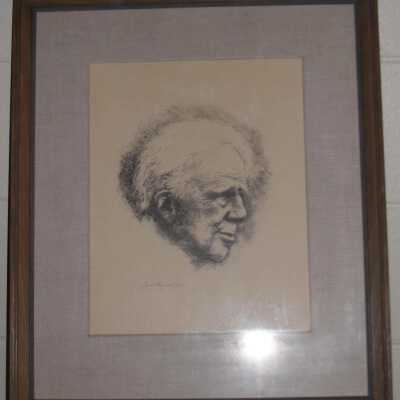

Robert Frost
Name/Title
Robert Frost
Description
Framed print of Robert Frost signed lower left "Grant Reynard, N.A." Head only - Frost as an old man looking to his right.
Acquisition
Accession
2008.62
Relationships
Related Person or Organization
Frost, Robert Lee (1874-1963)
Person or Organization
Artwork Details
Medium
Ink, Paper
Subject Person
Frost, Robert Lee (1874-1963)
Made/Created
Artist Information
Reynard, Grant Tyson (1887-1968)
Artist
Date made
May 1966
Dimensions
Width
19-1/2 in
Height
23 in
Entry/Object ID
2008.62.1
Context
Beloved poet Robert Frost spent a good part of his adult life in Vermont. Many of his most celebrated works were written at homes in Shaftsbury and Ripton. Though famous amongst literary circles for most of his life, Frost entered the world of popular culture with his recitation at the inauguration of John F. Kennedy. From 1921 until his death, he maintained a summer cabin in Ripton, Vermont, near the Middlebury College's Breadloaf campus. This work was drawn from life at the college in 1966. Frost is buried in the Old Bennington Cemetery. His epitaph reads, "I had a lover's quarrel with the world."
Grant Reynard was born on October 20, 1887, in Grand Island, Nebraska. He studied at the Art Institute of Chicago.
Reynard became a painter, etcher and lithographer in New Jersey. He drew illustrations for Redbook, The Saturday Evening Post, Harper's Bazaar, Collier's and Cosmopolitan. He was the president of the Montclair Art Museum, and a member of the National Academy of Design and the American Watercolor Society
Grant Reynard was born on October 20, 1887, in Grand Island, Nebraska. He studied at the Art Institute of Chicago.
Reynard became a painter, etcher and lithographer in New Jersey. He drew illustrations for Redbook, The Saturday Evening Post, Harper's Bazaar, Collier's and Cosmopolitan. He was the president of the Montclair Art Museum, and a member of the National Academy of Design and the American Watercolor Society
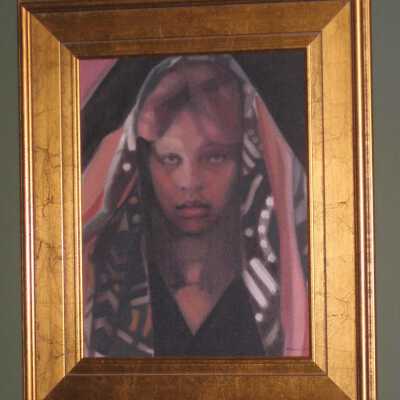

Study #1
Label
Janet McKenzie lives in Island Pond and is known for her powerful paintings of women. In the exhibition catalog, Art of Action: Ideas + Action= Change, she wrote about her artwork, "My paintings, created for the Art of Action project, celebrate humanity and speak through our people- Vermonters... This project provided an opportunity to pull back the 'veil of invisibility' that seems to cloak many of our Vermont-born ethnic minorities. Within our cities- and even with our most remote communities- people of all races, many here for generations, continue to contribute to and help define Vermont's diverse cultural reality."
The Art in Action Project was created by Lyman Orton, Janet Izzi, and the Vermont Arts Council to raise awareness and inspire citizen action around issues and challenges that shape Vermont social, political, and economic landscape. Ten artists were commissioned to examine the issues Vermonters deemed critical to our future and create two-dimensional works of art that articulate those issues. The suites of artwork, totaling 105 pieces, were completed in August 2009. The work then embarked on a tour of 27 venues, beginning in September 2009 and culminating in July 2010.
Catalog Information
Name/Title
Study #1
Description
Portrait of a young woman of color wearing a veil. She is wearing a dark V neck garment and one of her head veils have a large geometric design. Pink tones throughout the piece.
Acquisition
Accession
2010.34
Artwork Details
Medium
Oil
Made/Created
Artist Information
McKenzie, Janet
Artist
Date made
2009
Dimensions
Width
17 in
Height
20 in
Entry/Object ID
2010.34.1


The Masons
Name/Title
The Masons
Type of Painting
Description
Folk art portrait showing an adult woman, two children, and an adult man. The woman is at the left of the composition. She has white skin and dark hair, parted in the center. She is wearing a black dress and a white neckerchief or collar. At the center is a child (boy) wearing a pink dress. He has white skin and brown hair parted at the side. He is holding a green bird. Behind him is an older child (girl) wearing a black dress with red accents. She has white skin and brown hair parted at the center. At the left is the adult man. He has white skin and dark hair. He is wearing a white shirt, black stock, black vest, and black jacket.
Acquisition
Accession
1976.56
Relationships
Related Person or Organization
Mason, Norman (1803-1843), Mason, Caroline Betsy Weaver (1807-1841), Huntington, Caroline Amanda Mason (1834-1912), Mason, Norman Nelson (1937-1914)
Related Places
Place
Lowell
City
Massachusetts
State/Province
United States of America
Country
North America
Artwork Details
Medium
Oil
Subject
The Mason Family
Made/Created
Artist Information
Howes, Samuel P. (1806-1881)
Artist
Date made
1839-1841
Dimensions
N/A
Entry/Object ID
1976.56.1
Context
Betsy Weaver and Norman Mason were born and raised in Vermont. Married in Barre, Vermont, they soon moved to Lowell, Massachusetts where children Norman and Caroline were born. This work was probably painted in Massachusetts.
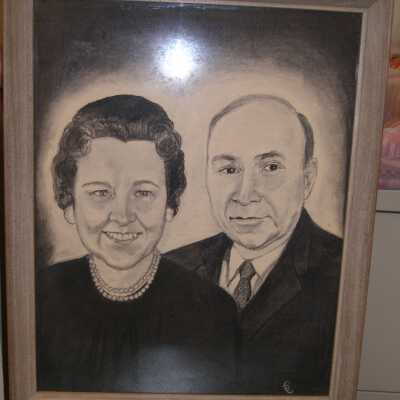

Vigilio and Ruth Cecchini
Name/Title
Vigilio and Ruth Cecchini
Description
Vigilio and Ruth Cecchini. Formal black and white portrait with Ruth sitting slightly in front of Vigilio - he is balding with dark hair and wearing a shirt, tie (with a print) and jacket and she has short curled dark hair, and is wearing a jewel neck (dress?) with a double strand of pearls. She has a full smile and he just has a hint of a smile.
Framed at the "Bangor Picture Framing Co. 102 Exchange St., Bangor, ME." There is a green sticker in the upper right corner on the back. Written in pencil on the back (upper left corner) is: "25th Anniversary / 10-31-56 / at Mario's Restaurant / Barre, Vt."
Framed at the "Bangor Picture Framing Co. 102 Exchange St., Bangor, ME." There is a green sticker in the upper right corner on the back. Written in pencil on the back (upper left corner) is: "25th Anniversary / 10-31-56 / at Mario's Restaurant / Barre, Vt."
Acquisition
Accession
2010.72
Artwork Details
Medium
Pastel
Subject Person
Cecchini, Vigilio (1909-1997), Copping, Ruth Agnes (1912-2005)
Made/Created
Artist Information
Connelly, Bud
Artist
Date made
1956
Dimensions
Width
17 in
Height
21-1/8 in
Entry/Object ID
2010.72.24
Context
This composition was created by Bud Connelly for Vigilio (Jiggs) and Ruth (Maggie) Cecchini's 25th Wedding Anniversary in 1956. He used two photographs taken that night as source material to create what looks like a formal double portrait. Jiggs was a pharmacist and worked for pharmacies in Barre and St. Albans. His large and extended family were part of the vibrant Italian community in Barre, Vermont during the early and mid-twentieth century.